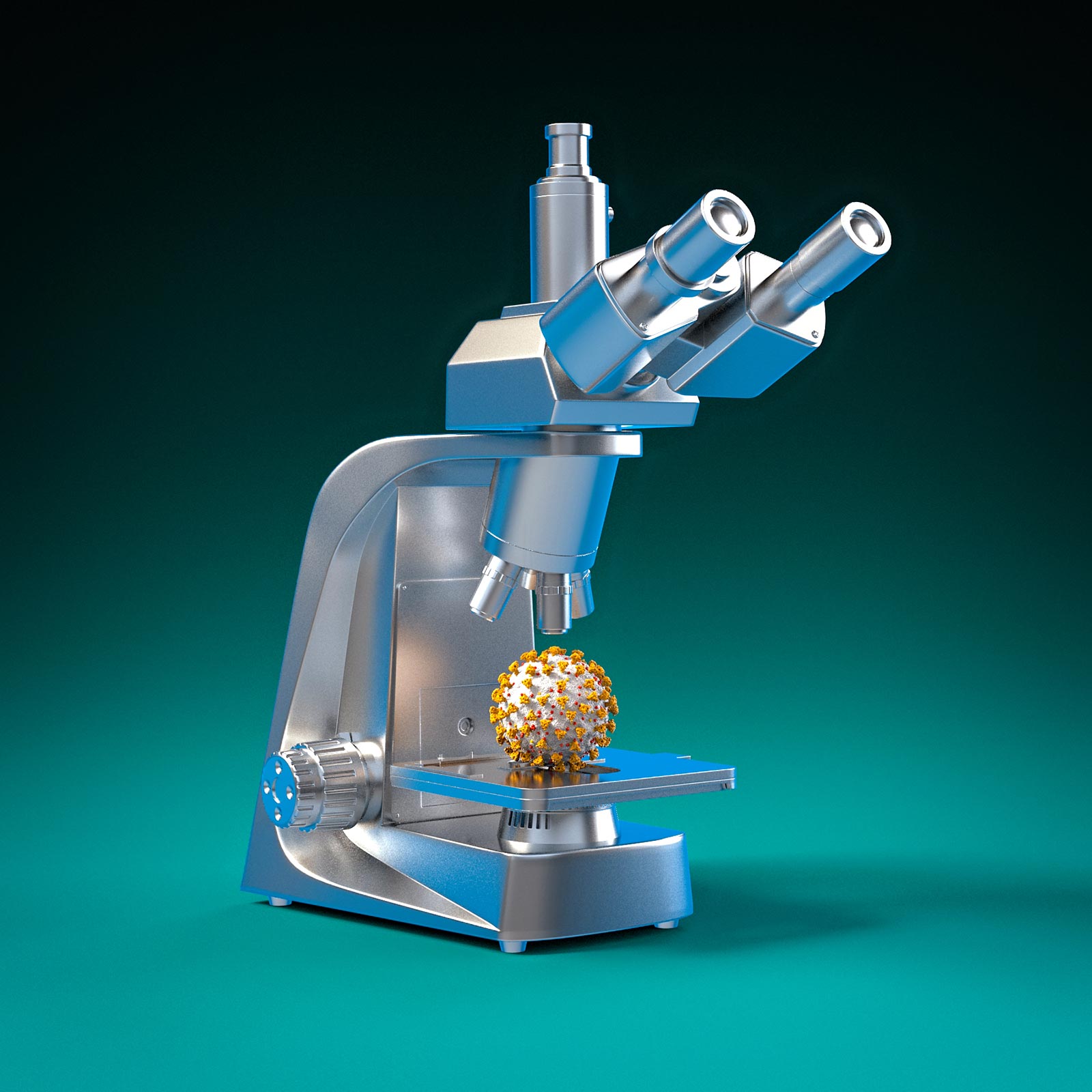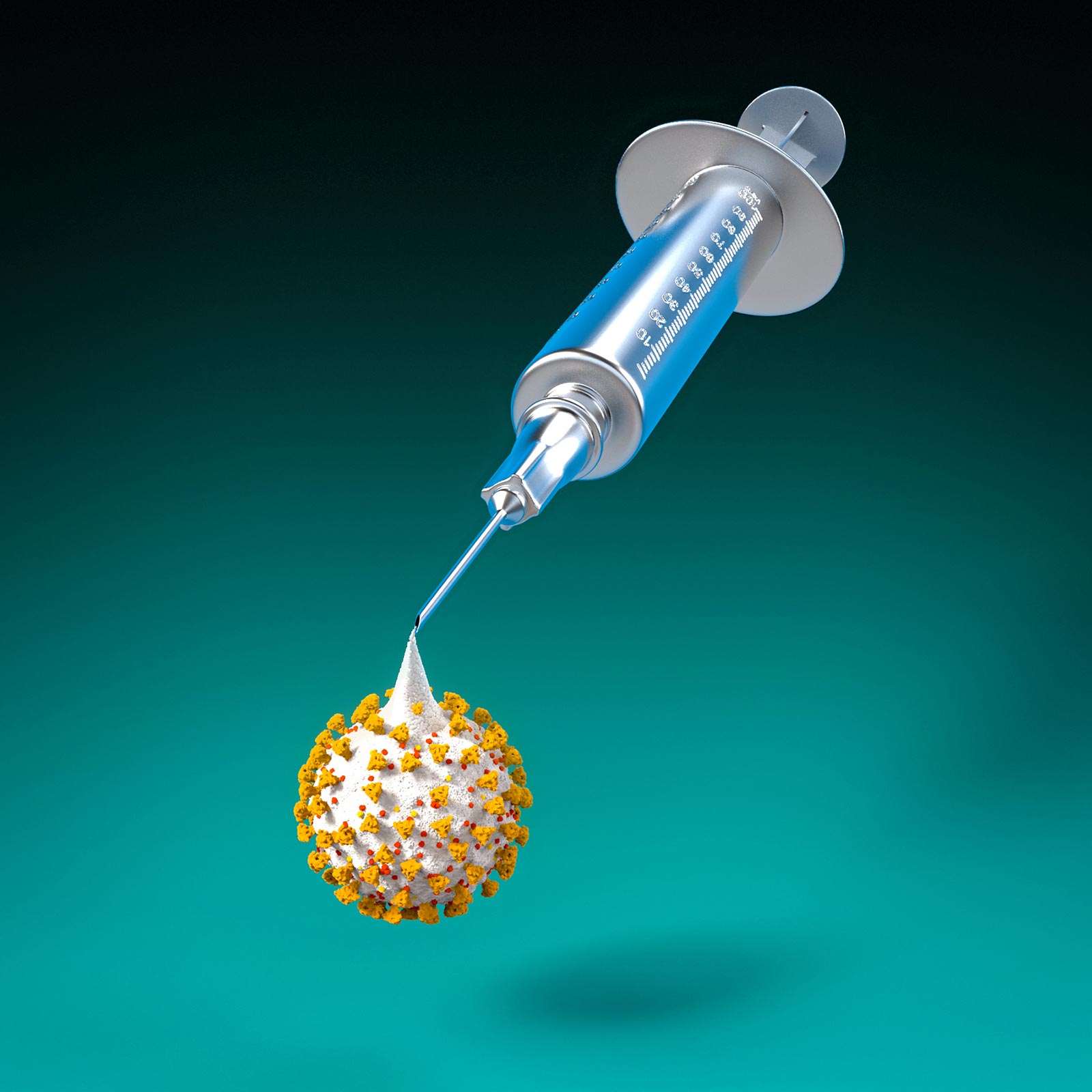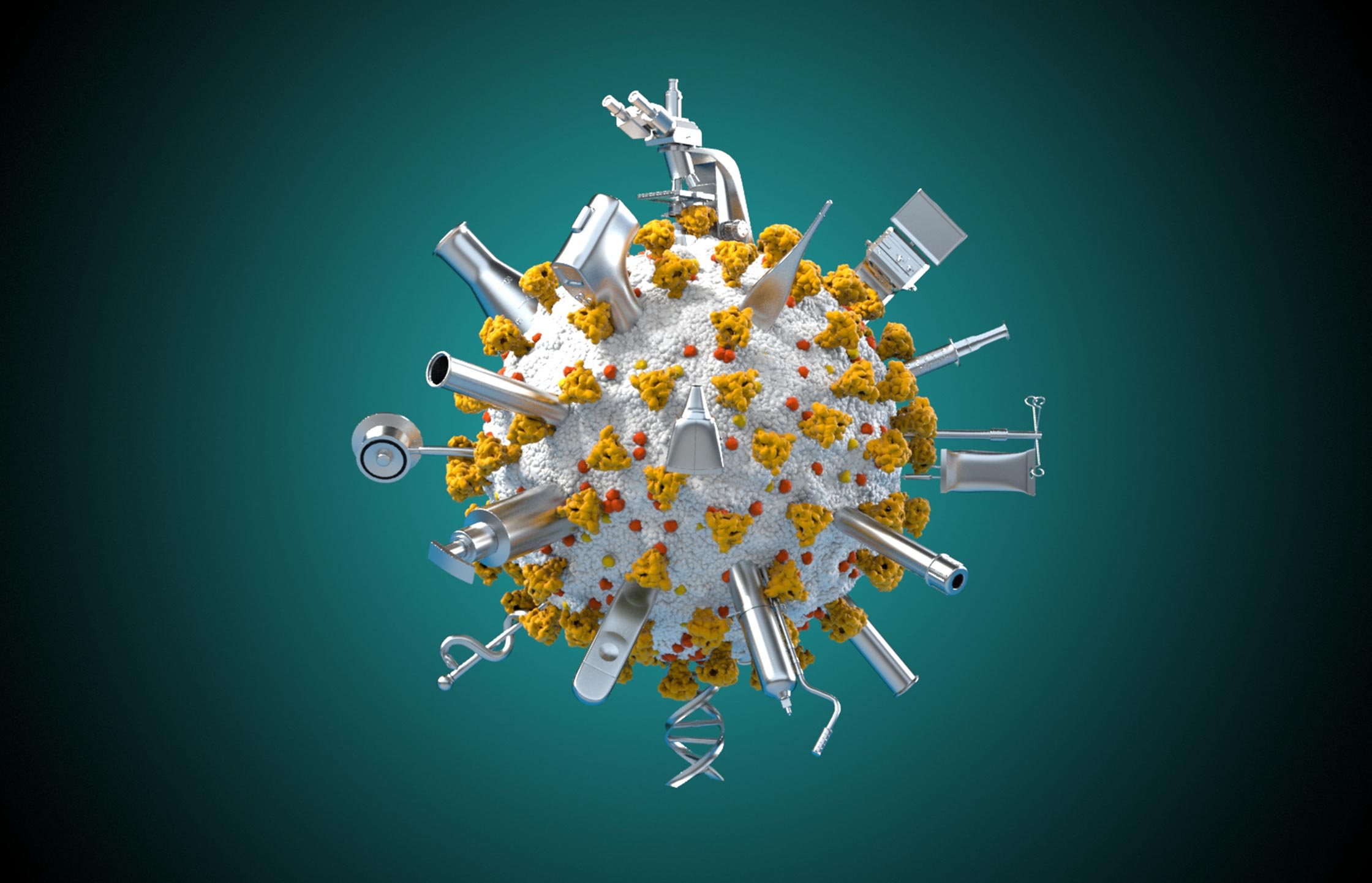Science Strikes Back
The Miller School continues its war against the coronavirus, and our researchers report progress on all fronts
By Josh Baxt
Illustrations by Eddie Guy
W
hen the COVID-19 pandemic first hit the U.S. in early March, the University of Miami Miller School of Medicine stepped up to meet the emerging threat. Researchers and clinicians quickly initiated COVID studies, supported by the Miller School’s Clinical & Translational Science Institute, the National Institutes of Health, and other funding sources. These early efforts to develop new diagnostics, treatments, and vaccines were detailed in the spring issue of this magazine.
“We were looking at rapid diagnostics and starting to ramp up vaccines,” said Carl I. Schulman, M.D., Ph.D., the Miller School’s executive dean for research. “We also focused on treatment algorithms and clinical trials to improve care. Because of that work, and research done around the world, the case fatality rate is less than half of what it was at the peak.”
And the work continues. Researchers collaborating with colleagues throughout the Miller School, and elsewhere in academia and at pharmaceutical companies, are advancing diagnostic tests, antibody therapies, and vaccines to put the coronavirus in check.
DIAGNOSTICS
– COVID Test Strips
Sylvia Daunert, Pharm.D., M.S., Ph.D., Lucille P. Markey Professor and chair of the Department of Biochemistry and Molecular Biology, in collaboration with Sapna Deo, Ph.D., and Jean-Marc Zingg, Ph.D., has been working on a fast, simple COVID-19 test strip that reads samples from saliva or nasal swabs like a pregnancy test — positive results produce two lines; negatives just one.
“It’s easy to visualize, and you don’t need expensive instrumentation,” Dr. Daunert said. “That’s why this type of platform is amenable for point-of-care locations, such as emergency rooms, doctor’s offices, or community health centers.”
Since May, the test received a U.S. patent in a record three months, and clinical studies have been launched with the Miller School’s Department of Pathology. The collaborators are also working with Chilean biotech company Merken to advance the test in South America. They hope to commercialize it next year.

– Oral Test
Otolaryngologist Elizabeth Franzmann, M.D., has been working with Vigilant Biosciences to adapt an oral cancer test to detect COVID-19. Because the original test is simple, inexpensive, and easy to use, it could be an ideal COVID-19 diagnostic.
To take the test, people simply swish saltwater in their mouths for a few seconds and spit into a cup — a much easier process than using nasopharyngeal swabs, which requires invasive, uncomfortable probing deep into the nose.
“We still need to do studies in patients, but we are quite excited about this technology,” Dr. Franzmann said. “A COVID antibody test that relies on oral rinses could be an important tool in the fight against COVID because it is rapid and does not require a blood draw or a lab.”
TREATMENTS
– Inhaled Nitric Oxide
A clinical trial led by pulmonologist and assistant professor Roger Argelio Alvarez, D.O., is testing whether inhaled nitric oxide (NO) can help stable COVID patients who need oxygen support.
Among its many functions, NO tells muscles around blood vessels to relax and open wider. Dr. Alvarez believes inhaled NO could encourage vessels in the lungs to take in more oxygen. For patients who aren’t showing obvious respiratory distress, NO could be a middle ground treatment, improving oxygenation without the side effects associated with intubation.
The multicenter, double-blind trial will enroll 500 patients to test INOpulse, a portable NO delivery system made by Bellerophon Therapeutics, which is sponsoring the trial. The study will help determine whether inhaled NO lowers mortality rates, reduces the need for mechanical ventilation, and is a viable substitute for intubation.
“We believe there’s a subgroup of patients who, if not for their low oxygen levels, would not need to be intubated,” Dr. Alvarez said. “If we could find another way to improve oxygenation, such as inhaled nitric oxide, we could really help these people.”
– Mesenchymal Stem Cells
Camillo Ricordi, M.D., director of the Diabetes Research Institute (DRI) and Cell Transplant Center, and collaborators at the DRI and in China have spent nearly a decade using umbilical cord-derived mesenchymal stem cells (MSCs) to increase insulin production and reduce the chronic complications associated with Type 1 diabetes. They have achieved excellent results.
More recently, Dr. Ricordi and collaborators in Italy and China have asked whether these immature cells, with their well-known anti-inflammatory properties, could help the sickest COVID-19 patients recover.
COVID-19 might even be a better application for MSCs. When transfusing them to treat diabetes, the cells are delivered to the pancreas following arterial catheterization in interventional radiology. This is because if they’re infused in a peripheral vein, like in a blood transfusion, more than 90% of MSCs remain trapped in the lung filter. This procedure, however, becomes an ideal delivery system in the case of a respiratory infection.
Early results have been promising. In a small, double-blind, randomized controlled trial, more than 90% of the patients who received MSC infusions survived, compared with fewer than 50% of those who received control infusions without the MSCs.
“Mesenchymal stem cells are anti-inflammatory, modulate the immune system, and also show antibacterial and antiviral properties,” Dr. Ricordi said. “In addition, we believe they promote organ regeneration and repair, as well as inhibiting lung fibrosis.”
– Convalescent Plasma
After patients recover from COVID, their blood plasma contains antibodies against the virus. As a result, convalescent plasma holds great promise to treat the disease. Early studies have been promising, but researchers need to conduct randomized controlled trials to show convalescent plasma is effective.
Shweta Anjan, M.D., assistant professor of internal medicine, who’s working with Drs. Dushyantha Jayaweera, Maria Alcaide and others, is overseeing three randomized controlled trials — two with outpatients and one with inpatients — in which participants are being treated with convalescent plasma.
The inpatient trial is studying plasma in adults with severe COVID symptoms, such as cough, difficulty breathing, and fever. The researchers follow patients for 90 days to determine if those who received plasma showed greater improvement than those in the control group.
The outpatient trials are testing whether convalescent plasma can prevent severe disease.
“We want to help health care workers or people in the transportation or service industries,” Dr. Anjan said. “Anyone who is interacting with people and risks being exposed to COVID can qualify.”
If you’re interested in joining an outpatient trial, please email COVIDplasmastudy@miami.edu.
– Regeneron Antibodies
In addition to testing convalescent antibodies, Miller School researchers are participating in a phase 3 trial for Regeneron’s antibody cocktail. This therapy combines two synthetic monoclonal antibodies that target different parts of the coronavirus’s spike protein — the structure that helps the virus get inside cells. Regeneron researchers hope that even if the virus mutates to defy one antibody, it can’t escape both.
Led by immunologist Gary I. Kleiner, M.D., Ph.D., associate professor of pediatrics and surgery, the study is testing whether the Regeneron therapy will prevent transmission in immune-compromised people.
“As an immunologist, I often help people with primary immune deficiencies, such as transplant and cancer patients,” Dr. Kleiner said. “They may not be COVID vaccine candidates or won’t respond to a vaccine when it’s available. This is more of a bridge, providing passive antibodies to hopefully keep them safe.”
The trial is looking for immune-compromised patients who’ve had a member of their household (not themselves) test positive within 96 hours. Call 305-243-5684 for more information.
– Cardiovascular Symptoms
For the coronavirus, a cell’s ACE2 receptor is the doorway inside. And while ACE2 is found throughout the body, it’s particularly concentrated in heart muscle cells. As a result, cardiologists have seen increases in heart problems, including arrhythmias and inflammation (myocarditis).
Last summer, German researchers conducted MRIs on recovering COVID patients, most of whom hadn’t been hospitalized, and found 60% showed evidence of ongoing heart inflammation. These findings set off alarm bells for cardiologists everywhere.
“We’re particularly concerned about our athletes,” said Jeffrey Goldberger, M.D., M.B.A., professor of medicine and chief of the Cardiovascular Division. “Most people who have myocardial involvement go back to their normal lives, and it’s not a big deal. But if you do vigorous exercise when you have myocarditis, you put yourself at risk for further worsening or, in rare cases, sudden death. Our team of specialists has developed a protocol for evaluation. We have screened more than 40 athletes and found about 5% have evidence of myocarditis.”
Dr. Goldberger, fellow cardiologist Raul Mitrani, M.D., and colleagues are investigating the long-term cardiovascular after-effects of COVID and have applied for an NIH grant to learn more.
“What happens after three or six months?” he asked. “Do they heal with no scar — heal with a scar? We want to look at this more carefully to assess for electrical abnormalities that might indicate fibrosis or scarring.”
VACCINES

– Using a Virus to Treat a Virus
Glen Barber, Ph.D., professor and chair of the Department of Cell Biology, has spent decades studying vesicular stomatitis virus (VSV), which has provided a valuable platform to investigate immunity and develop therapies.
The Barber lab has been working on VSV-based vaccines to treat hepatitis C, Zika and other viruses and is using a similar strategy against COVID-19.
“We’ve taken the spike in the envelope protein of COVID and SARS and basically put it onto VSV,” Dr. Barber said. “If we use that to inoculate people, then we can generate neutralizing antibodies, which hopefully will be sufficient to protect them if they get exposed to the real virus.”
Since May, the lab has developed a VSV that expresses the COVID spike protein and generates neutralizing antibodies in mice. Dr. Barber has applied for additional funding to evaluate these as a vaccine.
– Heat Shock Protein
Natasa Strbo, M.D., D.Sc., assistant professor in the Department of Microbiology and Immunology, has been working with Heat Biologics to develop a vaccine platform built around a protein called GP96.
GP96 is a heat-shock protein. It helps cells survive stressful conditions by ensuring other proteins are folded correctly. But it also acts as a cellular early warning system.
“These proteins are signaling molecules for the immune system,” Dr. Strbo said. “When a cell dies and the contents of that cell spill out, which happens during infections, GP96 alerts the immune system that something really bad just happened to that cell.”
To develop a COVID vaccine, the team is combining GP96 with SARS-CoV-2 antigens, which has great potential to wake up immune cells and generates T cells to clear infected cells.
In the past few months, Dr. Strbo’s team has generated two different vaccine cell lines. These vaccines have proven safe in animal studies and have activated coronavirus-specific T cells in the lungs and airways.
Unlike most vaccine candidates, which primarily trigger antibody responses, Dr. Strbo’s vaccine drives T cell immunity, antibody responses, and innate immunity. As a result, the vaccine could be used as a stand-alone vaccine or in combination with other agents to enhance efficacy.
“We just finished making a research vaccine cell bank that will be delivered to a biomanufacturing facility for clinical-grade vaccine production that should start in November,” Dr. Strbo said. “With our colleagues at Heat Biologics, we are setting up additional preclinical studies in preparation for a clinical trial in humans.”
– Moderna Vaccine Trial
In addition to conducting investigator-initiated trials to validate their own vaccines, Miller School researchers are partnering with pharmaceutical companies to test those vaccines in patients.
Susanne Doblecki-Lewis, M.D., M.S.P.H., associate professor of Clinical Medicine and clinical director of the Division of Infectious Diseases, is leading UM’s arm of Moderna’s multicenter vaccine trial. The nationwide study hopes to recruit 30,000 people — 1,000 in Miami.
“It’s an mRNA vaccine, which means it has genetic material that would code for the spike protein,” Dr. Doblecki-Lewis said. “That little bit of RNA is encased in a lipid nanoparticle, which enters cells. The body then makes that RNA into a small bit of the virus to generate an antibody response, which we hope will protect against real infections with real virus.”
– ENSEMBLE
In mid-October, another promising study, the ENSEMBLE trial, sponsored by Johnson & Johnson subsidiary Janssen Pharmaceuticals, was temporarily delayed when one participant became sick. While this may seem ominous, it’s a routine part of the clinical trial process.
“This is a normal function,” said Dushyantha Jayaweera, M.D., professor of medicine and principal investigator for Janssen’s UM site. “There’s a lot of scrutiny about vaccines right now, but if we didn’t have pandemic conditions, nobody would even notice the pause. Many studies get paused for various reasons — it’s actually routine. But of course, the path here is exaggerated because it’s a new vaccine for a new disease.”
In most cases, the event that triggers a clinical trial pause has nothing to do with the drug being tested, and the study moves forward. This particular trial is a randomized, double-blind study to assess safety and efficacy, which seeks to enroll up to 60,000 participants — 1,500 in South Florida.
“From a consumer perspective, this is an encouraging sign because it shows Janssen and others are serious about safety,” Dr. Jayaweera said. “They paused because they care about safety, and they are not pushing through to meet a deadline. They’re doing it the right way.”
– A New Type of Clinical Trial
COVID has accelerated existing efforts to make clinical trials more efficient. One of these is the I-SPY Trials.
The Miller School is one of 10 centers in the network. The goal is to conduct fast, adaptive trials that quickly rule out drugs that don’t work and advance those that do. The Miller School is the newest center to join the network, which was originally designed to advance breast cancer trials. Researchers believe this adaptive approach will provide important answers faster.
“We can test a medication really quickly,” said pulmonologist David De La Zerda, M.D., who leads the Miller School’s I-SPY efforts. “In about 48 hours to a week, we know if a COVID medication is having a positive signal, such as decreased mechanical ventilation or mortality. If we see that signal, the study is graduated to a full clinical trial. If it’s not working, we drop it off and go to the next therapy in line. It has the potential to really accelerate clinical trials, which is a pretty neat idea.”![]()



